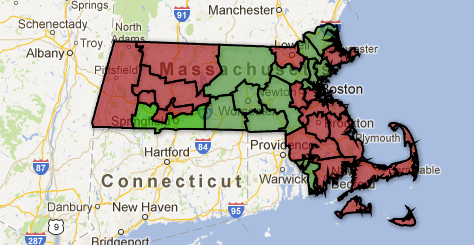Here’s a short story about helping my friends at the Metrowest Regional Center for Healthier Communities create some maps, and my reflections about existing efforts to make map-making easier. Short story – it worked, but being a big computer dork helped.
The issue at hand was their desire to create a map of the Community Health Network Areas (CHNAs) in Massachusetts, colored by a variety of data indicators. They had various goals and audiences in mind. Many Eyes makes it easier to map towns in Massachusetts, but these CHNA borders don’t line up with towns so we couldn’t use that. I decided to try another tool, Google Fusion Tables, because I knew it could import arbitrary geographic shapes. After some digging I found that the Massachusetts Oliver online GIS tool had a layer for CHNA boundaries. Even better, Oliver has KML output! Bingo. After looking through the various files I downloaded from the Oliver website, I was able to guess which one I needed to upload to Fusion Tables. With that, and some text changes in the resulting table, I was able to create a template my colleagues could use to create colored map visualizations for the CHNAs. Here’s an example map with some random fake data. Success!
So what’s the point? Well, I like to talk about how the barrier to entry for creating data presentations has been lowered by new technologies. Mapping is one area where this is particularly true – the idea that anyone can make and share a map using tools like Google Maps is truly astounding. That said, there is often a rocky transition when you try to deal with real data. This map was much easier to generate thanks to Fusion Tables, but still required me:
- learning the Fusion Tables model and user interface for data and visualizing
- understanding what GIS layers are
- navigating the GIS-centric Oliver website to find the CHNA layer that I cared about
- understanding the difference between the GIS files to know which KML to import into Fusion Tables
….and more. So it was convenient that I’m a computer geek who didn’t have too hard of a time figuring that stuff out.
Tools have made it easier, but as I’ve pointed out before you still need to learn a lot. This is why I don’t call tools like Fusion Tables “easy to use” on my tool matrix. When the rubber hits the road for map-making, sometimes you need to put on your GIS hat and pretend you know what you’re doing.


You must be logged in to post a comment.